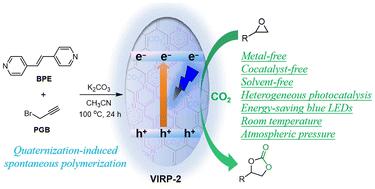用于可见光促进光催化二氧化碳环加成的共轭亚乙烯-扩展紫胶离子基聚乙炔的一步法合成†
IF 9.2
1区 化学
Q1 CHEMISTRY, MULTIDISCIPLINARY
引用次数: 0
摘要
在这项工作中,我们报道了一种简便的一锅策略,即构建共轭乙烯基延伸紫胶基离子自由基聚乙炔(简称 VIRPs),用于环境条件下可见光促进的光催化二氧化碳(CO2)环加成反应。正如预期的那样,离子聚合物 VIRP-1 是通过 1,2-双(4-吡啶基)乙烯(BPE)和丙炔基溴化物(PGB)在 100 °C 的 CH3CN 中发生季铵化诱导自发聚合(QISP)反应,在不使用任何催化剂和引发剂的情况下在原位直接制备 24 小时的。我们欣喜地发现,在 QISP 反应过程中使用 K2CO3 作为碱性还原剂,可以显著增强离子自由基聚合物 VIRP-2 的自由基性质,这与 VIRP-1 的合成类似,并通过电子顺磁共振(EPR)光谱和 X 射线光电子能谱(XPS)得到了证实。研究发现,K2CO3 的使用不仅实现了乙烯基延伸紫胶阳离子到稳定紫胶阳离子自由基的原位一电子还原,还能在合成过程中通过阴离子交换除去 VIRP-2 中的大部分 Br- 阴离子并生成非卤素阴离子 CO32-。离子自由基聚乙炔 VIRP-1 和 VIRP-2 都具有很强、很广的可见光收集能力,但自由基强度更强的 VIRP-2 具有更好的光诱导电荷分离和迁移能力。因此,离子自由基聚合物 VIRP-2 被认为是一种高效、绿色的无金属异相光催化剂,可在常温常压下,在不使用任何助催化剂和溶剂的情况下,通过可见光促进催化 CO2 与各种环氧化物转化为环碳酸盐。这项工作为在环境条件下构建特定任务离子自由基聚合物以实现光催化 CO2 环加成提供了新的方向。本文章由计算机程序翻译,如有差异,请以英文原文为准。

One-pot synthesis of conjugated vinylene-extended viologen ionic radical polyacetylenes for visible light-promoted photocatalytic CO2 cycloaddition†
In this work, we reported a facile one-pot strategy to construct conjugated vinylene-extended viologen-based ionic radical polyacetylenes (denoted as VIRPs) for visible light-promoted photocatalytic carbon dioxide (CO2) cycloaddition under ambient conditions. As expected, the ionic polymer VIRP-1 was directly prepared in situ by the quaternization-induced spontaneous polymerization (QISP) reaction between 1,2-bis(4-pyridyl)ethylene (BPE) and propargyl bromide (PGB) in CH3CN at 100 °C for 24 h without any catalysts and initiators. To our delight, the radical character of the ionic radical polymer VIRP-2 could be significantly enhanced by using K2CO3 as an alkaline reductant in the QISP reaction process, similar to the synthesis of VIRP-1, which was confirmed by electron paramagnetic resonance (EPR) spectroscopy and X-ray photoelectron spectroscopy (XPS). It was found that the use of K2CO3 not only achieved the in situ one-electron reduction of vinylene-extended viologen cations to stable viologen cationic radicals, but also could remove a large proportion of Br− anions and afford non-halogen anions CO32− within VIRP-2 by anion exchange during the synthetic process. Both ionic radical polyacetylenes VIRP-1 and VIRP-2 exhibit strong and broad visible light-harvesting ability; however, VIRP-2 with much stronger radical intensity possesses better photoinduced charge separation and migration ability. Therefore, the ionic radical polymer VIRP-2 was regarded as a highly efficient and green metal-free heterogeneous photocatalyst in the visible-light-promoted catalytic CO2 conversion with various epoxides into cyclic carbonates at room temperature and atmospheric pressure without using any cocatalysts and solvents. This work affords a new direction to construct task-specific ionic radical polymers towards photocatalytic CO2 cycloaddition under ambient conditions.
求助全文
通过发布文献求助,成功后即可免费获取论文全文。
去求助
来源期刊

Green Chemistry
化学-化学综合
CiteScore
16.10
自引率
7.10%
发文量
677
审稿时长
1.4 months
期刊介绍:
Green Chemistry is a journal that provides a unique forum for the publication of innovative research on the development of alternative green and sustainable technologies. The scope of Green Chemistry is based on the definition proposed by Anastas and Warner (Green Chemistry: Theory and Practice, P T Anastas and J C Warner, Oxford University Press, Oxford, 1998), which defines green chemistry as the utilisation of a set of principles that reduces or eliminates the use or generation of hazardous substances in the design, manufacture and application of chemical products. Green Chemistry aims to reduce the environmental impact of the chemical enterprise by developing a technology base that is inherently non-toxic to living things and the environment. The journal welcomes submissions on all aspects of research relating to this endeavor and publishes original and significant cutting-edge research that is likely to be of wide general appeal. For a work to be published, it must present a significant advance in green chemistry, including a comparison with existing methods and a demonstration of advantages over those methods.
 求助内容:
求助内容: 应助结果提醒方式:
应助结果提醒方式:


